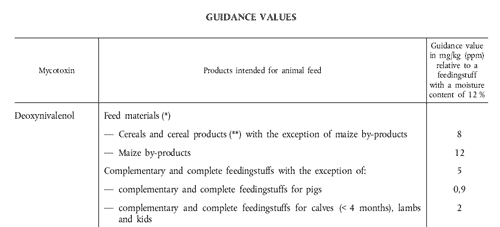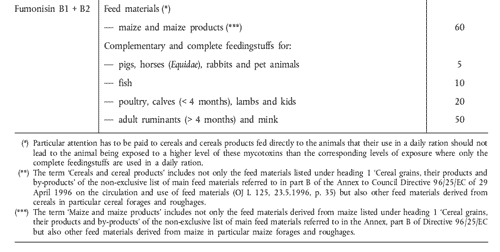Presence of deoxynivalenol, zearalenone, ochratoxin A, T-2 and HT-2 and fumonisins in products intended for animal feeding
23.8.2006 Official Journal of the European Union L 229/7
COMMISSION RECOMMENDATIONof 17 August 2006
on the presence of deoxynivalenol, zearalenone, ochratoxin A, T-2 and HT-2 and fumonisins in products intended for animal feeding
(Text with EEA relevance)
(2006/576/EC)
THE COMMISSION OF THE EUROPEAN COMMUNITIES,
Having regard to the Treaty establishing the European Community, and in particular the second indent of Article 211 thereof,
Whereas:
(1) At the request of the Commission the European Food Safety Authority (EFSA) adopted opinions on the myco- toxins deoxynivalenol on 2 June 2004 (1), zearalenone on 28 July 2004 (2), ochratoxin A on 22 September 2004 (3) and fumonisins on 22 June 2005 (4).
(2) Those opinions conclude that all four mycotoxins exhibit toxic effects in several animal species. Deoxynivalenol, zearalenone and fumonisin B1 and B2 are only to a very limited extent transferred from feed into meat, milk and eggs and therefore food of animal origin only contributes marginally to the total human exposure to these toxins. Ochratoxin A can be transferred from feed into food of animal origin but exposure assessments indicate that food of animal origin makes only a small contribution to the total human dietary exposure to ochratoxin A.
(3) Data on the presence of T-2 and HT-2 toxins in products intended for animal feeding are at present very limited. There is also an urgent need for the development and validation of a sensitive method of analysis. However there are indications that the presence of T-2 and HT-2 in products intended for animal feeding could be a reason for concern. Therefore, it is necessary to develop a sensitive method of analysis, collect more occurrence data, and carry out further investigations and research into the factors involved in the presence of T-2 and HT-2 in cereal and cereal products, in particular in oats and oat products.
(4) Taking into account the conclusions of the scientific opinions referred to in recital 1, and the lack of reliable data on T-2 and HT-2 toxins, together with the large year-to-year variation in occurrence of these myco- toxins, it is appropriate to collect more data on these mycotoxins in the different feed materials and feeding- stuffs, in addition to the data already available from the coordinated control programmes for 2002 (5), 2004 (6) and 2005 (7).
(5) To provide orientation to the Member States on the acceptability of cereals and cereal products and compound feed for animal feeding and to avoid dispa- rities in the values accepted by the different Member States and the consequent risk of distortion of compe- tition, it is appropriate to recommend guidance values.
(6) Member States should only apply the guidance values for fumonisin B1 + B2 from 1 October 2007, so as to coincide with the rules laid down by Commission Regu- lation (EC) No 856/2005 of 6 June 2005 amending Regulation (EC) No 466/2001 as regards Fusarium toxins (8).
(7) An assessment of the approach provided for by this Recommendation should be undertaken by 2009 in particular to assess its contribution towards protecting animal health. The monitoring data obtained as a result of this Recommendation will also enable a better under- standing of the year–to-year variance and the presence of these mycotoxins in the wide range of by-products used for animal feed, which is of primary importance for taking, if necessary, further legislative measures.
(1)Opinion of the Scientific Panel on contaminants in the Food Chain of the European Food Safety Authority (EFSA) on a request from the Commission related to deoxynivalenol as undesirable substance in animal feed, adopted on 2 June 2004. http://www.efsa.europa.eu/etc/medialib/efsa/science/contam/ contam_opinions/478.Par.0005.File.dat/opinion05_contam_ej73_ deoxynivalenol_v2_en1.pdf
(2)Opinion of the Scientific Panel on contaminants in the Food Chain of the European Food Safety Authority (EFSA) on a request from the Commission related to zearalenone as undesirable substance in animal feed, adopted on 28 July 2004. http://www.efsa.europa.eu/etc/medialib/efsa/science/contam/ contam_opinions/527.Par.0004.File.dat/opinion_contam06_ej89_ zearalenone_v3_en1.pdf
(3)Opinion of the Scientific Panel on contaminants in the Food Chain of the European Food Safety Authority (EFSA) on a request from the Commission related to ochratoxin A as undesirable substance in animal feed, adopted on 22 September 2004. http://www.efsa.europa.eu/etc/medialib/efsa/science/contam/ contam_opinions/645.Par.0001.File.dat/opinion_contam09_ej101_ ochratoxina_en1.pdf
(4)Opinion of the Scientific Panel on contaminants in the Food Chain of the European Food Safety Authority (EFSA) on a request from the Commission related to fumonisins as undesirable substance in animal feed, adopted on 22 June 2005. http://www.efsa.europa.eu/etc/medialib/efsa/science/contam/ contam_opinions/1037.Par.0001.File.dat/contam_op_ej235_ fumonisins_en1.pdf
(5)Commission Recommendation 2002/214/EC of 12 March 2002 on the coordinated inspection programmes in the field of animal nutrition for the year 2002 in accordance with Council Directive
95/53/EC (OJ L 70, 13.3.2002, p. 20).
(6)Commission Recommendation 2004/163/EC of 17 February 2004 on the coordinated inspection programme in the field of animal nutrition for the year 2004 in accordance with Council Directive
95/53/EC (OJ L 52, 21.2.2004, p. 70).
(7)Commission Recommendation 2005/187/EC of 2 March 2005 on the coordinated inspection programme in the field of animal nutrition for the year 2005 in accordance with Council Directive 95/53/EC (OJ L 62, 9.3.2005, p. 22).
(8)OJ L 143, 7.6.2005, p. 3.
HEREBY RECOMMENDS:
1. Member States should, with the active involvement of feed business operators, increase monitoring for the presence of deoxynivalenol, zearalenone, ochratoxin A and fumonisin B1 + B2, T-2 and HT-2 toxin in cereals and cereal products intended for animal feeding and compound feedingstuffs.
2. Member States should ensure that samples are simulta- neously analysed for the presence of deoxynivalenol, zeara- lenone, ochratoxin A, fumonisin B1 + B2 and T-2 and HT-2 toxin to allow the extent of co-occurrence to be assessed.
3. Member States should pay particular attention to the presence of those mycotoxins in by- or co-products from the production of food intended for animal feeding.
4. Member States should ensure that the analytical results are provided on a regular basis to the Commission for compi- lation into a single database.
5. Member States should ensure that the guidance values, as set out in the Annex, are applied for judging the acceptability of compound feed and cereal and cereal products for animal feeding. As regards fumonisin B1 + B2, Member States should apply these guidance values from 1 October 2007.
6. Member States should ensure, in particular, that feed business operators use in their Hazard Analysis and Critical Control Points (HACCP) system (1) the guidance values referred to in point 5 to determine the critical limits at critical control points which separate acceptability from unacceptability, for the prevention, elimination or reduction of identified hazards.
In applying these guidance values, Member States should take into account the fact that the guidance values for cereals and cereal products have been determined for the most tolerant animal species and are therefore to be considered as upper guidance values.
For feed for more sensitive animals, Member States should ensure that lower guidance values for cereals and cereal products are applied by feed manufacturers taking into account the sensitivity of the animal species and enabling compliance with the guidance values determined for compound feedingstuffs for these animal species.
Done at Brussels, 17 August 2006.
For the Commission
Markos KYPRIANOU
Member of the Commission


Thanks Mr Omede, for your observation about Nigerian's technical deficiency as regards aflatoxin mitigation in poultry production.. An NGO (Livestock Industry Foundation for Africa, LIFA) has been created by Dr Stephen Adejoro & co, which would see among others , to the mitigation of natural and man made risks militating against the poultry and livestock industry in Africa ( especially climate change aflatoxin induced mitigation) . More technical supports are encouraged to input into the NGO to fund aflatoxin mitigation research in Africa including Nigeria. Thanks
Aflatoxicosis is currently a major limitatiom to poultry health and productivity in Nigeria. Lack of adequate laboratory services is the big challange facing the management or this poultry problem.
Recently private laboratory in Nigeria are spinging up to assist farmers in the management of this disease.
The most prevalent and mostly diagnosed mycotoxin in Nigeria is aflatoxin B1.
I believe that the minimization of mycotoxin contamination to poultry feed must take the lead in strategic formulation on feed milling policy in Africa.
Dr Stephen Adejoro
Poultry management consultant
Nigeria
Dear Chrissy Moon,
I agree with you and I think that some of the guidance values should be revised and reduced since I consider that they are high and with risk for the animals. However the collaboration of all EU country members is necessary to provide results (see de Hereby Recommends in the published article) to the commission to allow the future publication of the final maximum allowed concentrations of those mycotoxins. Thus the guidance values published are considered, for the time being, as “Acts whose publication is not a condition for its applicability”. It is my opinion.
Alberto Gimeno
Technical Consultant in Animal Nutrition and Mycotoxicology
Interesting about mycotoxins in products for animal feeding. According to the Official Journal of the European Union (Spanish Edition, ISSN 1725-2512, L229, August 23, 2006), The Guidance Values published, are considered for the time being as “Acts whose publication is not a condition for its applicability”.
Alberto Gimeno
Technical Consultant in Animal Nutrition and Mycotoxicology
Dr Adejoro pointed out a major issue on mycotoxins that affects Nigeria. There is need for further studies in this area in Nigeria. Many losses suffered by livestock farmers in Nigeria could largely be traced to this. We hope also that technical support shall be provided to help Nigeria arrive at results that will give a good knowledge on the Nigerian mycotoxin status.
Mycotoxin zearalenone (zen) impairs fertility in farm animals. Pig is the most sensitive species to zearalenone toxicosis, especially prepubertal gilts. Our lab investigated the effect of zearalenone and its major metabolite (á - zearalenol) on boar sperm characteristics and binding capacity, under in vitro conditions. Zen and a-zen have a direct toxic effect on boar sperm and their effect is time- and dose-dependent. These results possibly indicate that ingestion of zen and a-zen could affect spermatozoa in the epididymis and cause lower motility of ejaculated spermatozoa. As zen and a-zen mycotoxicosis is a very common problem in the pig industry, further investigations relative to pathway of zen action, in vivo administration of zen on boar, in vitro fertilization under zen and a-zen influence and induction of acrosome reaction are needed.
Dr Ioannis Tsakmakidis
DVM PhD
Dear Dr.
Feed and fodder origin mycotoxins are not only going to food chain, they are also affecting male and female reproduction in terms of spermatogenesis and folliculogenesis, thereby reducing the reproductive success in farm animals.
Thank you.

Your network about mycotoxins in products for animal feeding is a very useful one.
Thanking you.
No doubts that aflatoxicosis consider a limiting factor to animal production industry worldwide. I think stating the problem and indicating the limits should be accompanied with a clear method for determination of that limits. On the other hand we should recommend natural anti-aflatoxicosis feed additives (prebiotics, probiotics, phytobiotics, etc) to minimize the effect of mycotoxin and aflatoxicosis to stress on birds and human health and welfare.







.jpg&w=3840&q=75)







.jpg&w=3840&q=75)